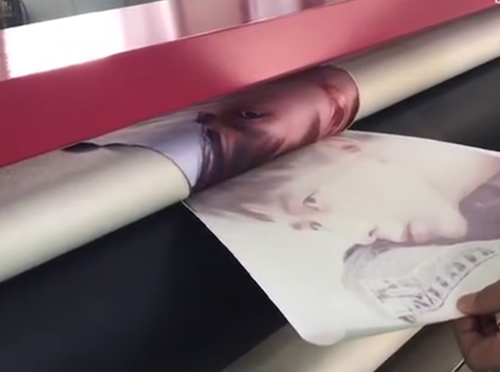Personalized creativity, 10 years of focus on
gift umbrella/sun umbrella production and wholesale
Personalized creativity, 10 years of focus on
gift umbrella/sun umbrella production and wholesale

We commonly see many umbrellas printed with various types of advertising, so how many different types of umbrella printing are there? Those printing methods are more durable and do not fade easily.
Today we are introducing the three types of umbrella printing:Digital Printing,Silk Printing,Thermal transfer printing.
Silk Printing
Silk printing is a type of aperture plate printing, which is known as one of the four main printing methods along with lithography, letterpress and gravure. Hole-plate printing includes transcription plates, cut-out flower plates, spraying and screen printing. The principle of hole-plate printing is: the printing plate (paper film plate or other plates on the plate base to create a hole through the ink) in the printing, through a certain pressure so that the ink through the hole hole plate eye transfer to the substrate (paper, ceramic, etc.) to form the image or text.
During printing, the ink is transferred to the substrate through the mesh of the graphic part by the squeezing of the squeegee, forming the same graphic as the original. Screen printing equipment is simple, easy to operate, simple and inexpensive to print and make plates, and highly adaptable. Screen printing can be used for a wide range of common printing products: colour paintings, posters, business cards, framed covers, commodity labels and printed textiles.
Three types of plate making methods are commonly used: direct plate making method, indirect plate making method, straight between the mixed plate making method.
1, direct plate making method
Method: direct plate making method is in the plate making first coated with photosensitive material wrist film base photographic film face up flat on the workbench surface, the taut wrist screen frame flat on the base, and then in the frame into the photosensitive paste and soft scraper pressure coating, after drying fully uncovered the plastic base, attached to the photographic film wrist screen can be used for the sun, by the development, after drying out the screen printing plate.
Process flow: has been taut screen - degreasing - drying - stripping the sheet base - exposure - development - drying - repair - sealing network
2, indirect plate making method
Method: The indirect plate making method is to expose the indirect film first, hardened with 1.2% H2O2 and then developed with warm water, dried and made into a peelable graphic negative, plate making will be graphic negative film surface and taut screen, by squeezing the film and wet screen paste solid, uncover the base, dry with the wind to make screen printing plate.
Processes.
1). Has been taut screen - degreasing - drying
2). Indirect film - exposure - hardening - development - lamination - blowing dry - trimming - printing. -blowing dry - plate repair - sealing the network
3, straight between the mixed plate making method
First the photopolymer layer with water, alcohol or photopolymer sticky on the screen frame, after hot air drying, remove the photographic film base, and then solarization, after the development process that is made of screen plate.
Advantages of screen printing.
(1) Not limited by the size and shape of the substrate
General printing, only in the plane, and screen printing can not only be printed on a flat surface can also be printed on special shapes of forming objects such as spherical surfaces, there are shapes of things can be used to screen printing.
(2) Soft surface printing pressure is small
The screen is soft and flexible.
(3) High ink coverage
Pure white printing on all black paper with a strong three-dimensional feel.
(4) Suitable for all types of inks
(5) High spin resistance
The gloss of the print remains unchanged. (Neither temperature nor sunlight has any effect). This makes it possible to print some self-adhesives without additional processes such as laminating.
(6) Flexible and varied printing methods
(7) Easy plate making, cheap and technically easy to handle
(8) High adhesion
(9) Can be screen printed by hand or by machine
Thermal transfer printing

Thermal transfer printing is also known as in-mould decals and in-mould labels, in which the functional and carrier layers of the label are thermally bonded to each other by the forming pressure of the hot molten plastic and by the heat energy. and adheres to the surface of the substrate and does not detach
(1) Classification of thermal transfer technology
Thermal transfer technology can be divided into thermal sublimation transfer and thermal pressure transfer according to the variety of oil film used. Heat pressure transfer is mainly used in the plastic forming machine in the process of plastic forming the full use of thermal pressure and heat to achieve a technical measure of printing pressure, and this heat transfer technology is the transfer of the label, concave inlay in the substrate's surface inside.
Thermal sublimation refers to the phenomenon of direct conversion of solid substances into a gaseous state under certain conditions of pressure as well as temperature. Thermal sublimation transfer printing mainly refers to the process of direct transformation of the dye in sublimation ink from a solid state to a gaseous state, and the dye is sublimated and then condensed into a solid state on the surface of the substrate. Thermal sublimation transfer printing technology also relies on heating and pressurised thermal transfer methods, and thermal sublimation transfer printing technology is also known as gas phase transfer printing.
Heat transfer technology can be divided into flat, screen, letterpress, gravure ribbon printing and inkjet from the printing method. The substrates can be divided into plastic films, plastic sheets, ceramics, fabrics and metal coating layers. From the substrate can be divided into thermal transfer plastic film and thermal transfer paper.
(2) Features of thermal transfer technology
Through the thermal transfer machine, the patterns and logos on the transfer film are transferred onto the surface of the product, thus fusing the formed oil film layer with the surface of the product to be transferred.
The characteristics of the thermal transfer technology are as follows: ①The thermal transfer technology has fewer processes, simple equipment, high production efficiency and low cost, and the added value of the product is relatively high. ②There is no environmental pollution in thermal transfer technology, which is a green printing technology and meets international non-toxic standards. ③The products produced are not only colourful, glossy and strong in adhesion, but also resistant to corrosion, alcohol, ageing, impact and abrasion.
Digital Printing
Digital printing is a printing technique that uses an inkjet printer to input the pattern of the school uniform as a digital signal into a computer, which then controls the inkjet to draw the pattern on the fabric. Digital printing allows a high degree of freedom to combine designs and flexibility to change designs without the need for plates, offering more possibilities to explore new patterns for school uniforms.
Because digital printing technology can use digital patterns, after the computer for colour measurement, colour matching, printing, so that the digital printing products can theoretically reach 16.7 million kinds of colours, breaking through the traditional textile printing pattern set of colour restrictions, especially in the colour gradient, cloud pattern and other high-precision pattern printing, digital printing in technology has incomparable advantages.
As one of the leading high-end school uniform customisation brands in China, Hafling applies advanced digital printing technology, which allows designers to freely adjust the print pattern and its shades during the production process, greatly expanding the space for school uniform print pattern design and enhancing the external style and internal quality of school uniforms.
At the same time, digital printing has significant advantages in terms of environmental protection. The printing process is "on-demand" by the computer, and the high precision of the printing makes it possible to print without using water or colour paste, without the waste of dyeing materials, waste water and noise, so that the printing process does not produce pollution, thus getting rid of the disadvantages of traditional screen printing with high energy consumption, high pollution and high noise, and achieving a green production process. Digital printing allows the production of school uniforms to be sustainable throughout its life cycle, bringing a technological revolution to the textile printing and dyeing sector.
 Factory salesProfessional umbrella manufacturer
Factory salesProfessional umbrella manufacturer Design samplesFree design and changes
Design samplesFree design and changes Professional TeamOne-to-one with a quality advisor
Professional TeamOne-to-one with a quality advisor On-time deliveryOn-time delivery by logistics
On-time deliveryOn-time delivery by logistics After Sales GuaranteeCustomer service perfection
After Sales GuaranteeCustomer service perfectionEmail:GreenSoure@foxmail.com Address:PolyStone Plaza, No.1 Huan Sheng Street, Nansha District, Guangzhou, China
IIT filing number.粤ICP备2021127261号

 Customer Service
Customer Service
 Customer Service
Customer Service